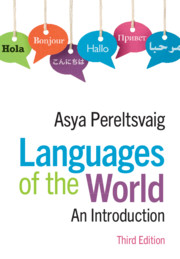Refine search
Actions for selected content:
6584 results in Grammar and Syntax
Acknowledgements
-
- Book:
- An Introduction to English Sentence Structure
- Published online:
- 24 September 2020
- Print publication:
- 15 October 2020, pp xii-xii
-
- Chapter
- Export citation
3 - Adjuncts
-
- Book:
- An Introduction to English Sentence Structure
- Published online:
- 24 September 2020
- Print publication:
- 15 October 2020, pp 108-151
-
- Chapter
- Export citation
1 - Grammar
-
- Book:
- An Introduction to English Sentence Structure
- Published online:
- 24 September 2020
- Print publication:
- 15 October 2020, pp 1-53
-
- Chapter
- Export citation
Contents
-
- Book:
- An Introduction to English Sentence Structure
- Published online:
- 24 September 2020
- Print publication:
- 15 October 2020, pp vii-viii
-
- Chapter
- Export citation
2 - Heads, Complements and Specifiers
-
- Book:
- An Introduction to English Sentence Structure
- Published online:
- 24 September 2020
- Print publication:
- 15 October 2020, pp 54-107
-
- Chapter
- Export citation
Copyright page
-
- Book:
- Grammar
- Published online:
- 10 September 2020
- Print publication:
- 01 October 2020, pp iv-iv
-
- Chapter
- Export citation
4 - Language Learning and Acquisition
-
- Book:
- Grammar
- Published online:
- 10 September 2020
- Print publication:
- 01 October 2020, pp 117-160
-
- Chapter
- Export citation
References
-
- Book:
- Grammar
- Published online:
- 10 September 2020
- Print publication:
- 01 October 2020, pp 192-205
-
- Chapter
- Export citation
Index
-
- Book:
- Grammar
- Published online:
- 10 September 2020
- Print publication:
- 01 October 2020, pp 206-208
-
- Chapter
- Export citation
5 - Language Education
-
- Book:
- Grammar
- Published online:
- 10 September 2020
- Print publication:
- 01 October 2020, pp 161-191
-
- Chapter
- Export citation
2 - Language and Languages
-
- Book:
- Grammar
- Published online:
- 10 September 2020
- Print publication:
- 01 October 2020, pp 41-77
-
- Chapter
- Export citation
3 - Grammar and Grammars
-
- Book:
- Grammar
- Published online:
- 10 September 2020
- Print publication:
- 01 October 2020, pp 78-116
-
- Chapter
- Export citation
1 - A Guide to the Linguists’ Guide to Grammar
-
- Book:
- Grammar
- Published online:
- 10 September 2020
- Print publication:
- 01 October 2020, pp 1-40
-
- Chapter
- Export citation
Contents
-
- Book:
- Grammar
- Published online:
- 10 September 2020
- Print publication:
- 01 October 2020, pp v-vi
-
- Chapter
- Export citation

Languages of the World
- An Introduction
-
- Published online:
- 30 September 2020
- Print publication:
- 03 September 2020
-
- Book
- Export citation

An Introduction to English Sentence Structure
-
- Published online:
- 24 September 2020
- Print publication:
- 15 October 2020
-
- Textbook
- Export citation
Language Index
-
- Book:
- The Syntax of Relative Clauses
- Published online:
- 10 September 2020
- Print publication:
- 24 September 2020, pp 388-391
-
- Chapter
- Export citation
1 - Preliminaries
-
- Book:
- The Syntax of Relative Clauses
- Published online:
- 10 September 2020
- Print publication:
- 24 September 2020, pp 4-19
-
- Chapter
- Export citation
5 - Some Residual Questions
-
- Book:
- The Syntax of Relative Clauses
- Published online:
- 10 September 2020
- Print publication:
- 24 September 2020, pp 256-280
-
- Chapter
- Export citation
Contents
-
- Book:
- The Syntax of Relative Clauses
- Published online:
- 10 September 2020
- Print publication:
- 24 September 2020, pp vii-viii
-
- Chapter
- Export citation
